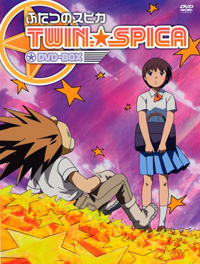

The Japanese science fiction manga series Twin Spica (ふたつのスピカ, Futatsu no Supika), written and illustrated by Kou Yaginuma, was adapted into a 20-episode anime series in 2003 and a 7-episode live-action series in 2009. All three productions tell a coming-of-age story of teenager Asumi Kamogawa as she trains to become an astronaut at a fictional space academy in the near future.[1]
Japanese animation studio Group TAC produced Twin Spica's anime adaptation, which was broadcast by NHK. The series premiered on November 1, 2003, and aired until its conclusion on March 27, 2004. Tomomi Mochizuki directed the anime series, and Rika Nakase wrote its screenplay. Masako Goto designed the characters for animation.[2] When the series reached its conclusion, fewer than 30 chapters of the manga had been published.[3] Chapter 25, which concludes the story of Asumi and her classmates undergoing a test of their survival skills, was the final chapter to be adapted for the anime.[4] Consequently, the series concludes prematurely with Asumi's ghost companion Lion-san leaving when he no longer has anything to teach her and her friends. The manga, however, continues with Lion-san appearing in subsequent chapters and ended serialization on August 5, 2009.[1] The anime series also aired in Japan, other parts of Asia, and Latin America on Animax.[5][6][7] The song "Venus Say" by female pop musical group Buzy (band) was used as the opening theme. Male pop group Begin adapted Kyu Sakamoto's 1963 single "Miagete Goran Yoru no Hoshi o" (見上げてごらん夜の星を, lit. "Look Up at the Stars at Night") as the ending theme.[2]
NHK announced a live-action Twin Spica adaptation on March 30, 2009, produced in cooperation with the Japan Aerospace Exploration Agency, the country's national aerospace agency. Sixteen-year-old actress Nanami Sakuraba was cast for the role of Asumi Kamogawa. Filming for the series began on April 2,[8] and it was scheduled to air on June 11 but was eventually postponed by one week until June 18.[9] The series aired weekly on NHK General TV and NHK BS Hi-Vision until its conclusion on July 30. Screenplay for the series was written by Shūko Arai and Daigo Matsui.[10] While writing the script, Arai found himself encouraged by the characters who must overcome various struggles in order to achieve their dreams. He also specified hopes and dreams as central themes in the story.[11] Among the changes made in this adaptation is the removal of Lion-san as a central character.[12] Alternative rock band Orange Range's 2009 single "Hitomi no Saki ni" (瞳の先に, lit. "Ahead of Eyes") was used as the ending theme.[13]
The anime adaptation was released in both VHS and DVD formats by King Records. Both were released in five compilation volumes containing four episodes each.[14] A special DVD collection containing the five flashback episodes—episodes 1, 5, 9, 12, and 16—from the anime was released on May 26, 2004,[15] and a five-disc DVD box set was released on July 22, 2004.[16] A three-disc DVD compilation box set of the live-action adaptation will be released by Geneon Universal Entertainment on December 23, 2009.[13]
- ^ a b "Twin Spica Sci-Fi Coming-of-Age Manga Ends in Japan". Anime News Network. August 7, 2009. Retrieved October 22, 2009.
- ^ a b スタッフ [Staff] (in Japanese). NHK. Archived from the original on November 7, 2012. Retrieved October 22, 2009.
- ^ Chapter 31 was published in the May 2004 issue of Comic Flapper on April 5, 2004. Yaginuma, Kou (December 22, 2004). Twin Spica Volume:07 (in Japanese). Tokyo: Media Factory. p. 191. ISBN 978-4-8401-0984-0.
- ^ Yaginuma, Kou (April 23, 2004). "Mission:25". ふたつのスピカ 6 [Twin Spica 6] (in Japanese). Tokyo: Media Factory. pp. 3–32. ISBN 978-4-8401-0944-4.
- ^ ふたつのスピカ [Twin Spica] (in Japanese). Animax. Archived from the original on October 20, 2010. Retrieved October 30, 2009.
- ^ Adesara, Hetal (June 15, 2005). "The Boy Factor". Indiantelevision.com. Retrieved October 27, 2009.
- ^ "Finaliza manga de Twin Spica" (in Spanish). Animax. August 22, 2009. Retrieved October 22, 2009.[permanent dead link]
- ^ "桜庭ななみ、NHKで地上波連ドラ初主演…6月スタート「ふたつのスピカ」" [Nanami Sakuraba lead role in NHK June premiere of Twin Spica]. Yomiuri Shimbun. March 30, 2009. Retrieved October 21, 2009.
- ^ "Twin Spica Manga to Get Live-Action TV Drama". Anime News Network. March 30, 2009. Retrieved October 21, 2009.
- ^ "JAXA全面協力!ドラマ8「ふたつのスピカ」" [JAXA collaboration! Drama 8 "Twin Spica"] (in Japanese). NHK. March 30, 2009. Retrieved October 28, 2009.
- ^ ドラマのみどころ [Drama Highlights] (in Japanese). NHK. Archived from the original on January 28, 2010. Retrieved October 28, 2009.
- ^ "キャスト" [Cast]. NHK. Retrieved October 28, 2009.
- ^ a b よくあるご質問 [FAQ] (in Japanese). NHK. Archived from the original on June 14, 2009. Retrieved October 22, 2009.
- ^ "DVD CDなど" [DVD and CD] (in Japanese). NHK. Archived from the original on August 29, 2012. Retrieved October 22, 2009.
- ^ ふたつのスピカ 特別話集 [Twin Spica Special Story Collection] (in Japanese). Starchild. Retrieved November 15, 2009.
- ^ "ふたつのスピカ DVD-BOX" [Twin Spica DVD-BOX] (in Japanese). Oricon. Retrieved November 15, 2009.